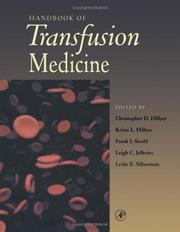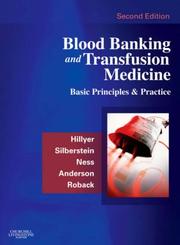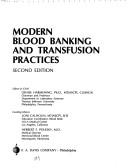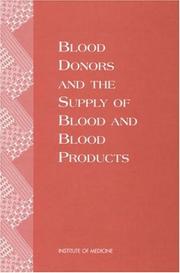| Listing 1 - 10 of 17 | << page >> |
Sort by
|
Book
ISBN: 0821444530 9780821444535 9780821420379 0821420372 Year: 2013 Publisher: Athens, Ohio : Ohio University Press,
Abstract | Keywords | Export | Availability | Bookmark
 Loading...
Loading...Choose an application
- Reference Manager
- EndNote
- RefWorks (Direct export to RefWorks)
This first extensive study of the practice of blood transfusion in Africa traces the history of one of the most important therapies in modern medicine from the period of colonial rule to independence and the AIDS epidemic. The introduction of transfusion held great promise for improving health, but like most new medical practices, transfusion needed to be adapted to the needs of sub-Saharan Africa, for which there was no analogous treatment in traditional African medicine. This otherwise beneficent medical procedure also created a "royal road" for microorganisms, and thus played a central
AIDS (Disease) --- Blood banks --- Blood --- Banked blood --- Blood transfusion service --- Blood transfusion services --- Tissue banks --- Bloodmobiles --- Body fluids --- Fear of blood --- Epidemiology. --- Risk management --- Transfusion --- History. --- Transportation
Book
ISBN: 163485005X 9781634850056 9781634849784 Year: 2017 Publisher: New York : Nova Biomedical,
Abstract | Keywords | Export | Availability | Bookmark
 Loading...
Loading...Choose an application
- Reference Manager
- EndNote
- RefWorks (Direct export to RefWorks)
Blood --- Blood banks --- Blood banks. --- Banked blood --- Blood transfusion service --- Blood transfusion services --- Tissue banks --- Bloodmobiles --- Body fluids --- Fear of blood --- Transfusion --- Transportation

ISBN: 128103715X 9786611037154 0080533256 0123487757 9780123487759 9781429498371 1429498374 9780080533254 9781281037152 6611037152 Year: 2001 Publisher: San Diego, CA : Academic Press,
Abstract | Keywords | Export | Availability | Bookmark
 Loading...
Loading...Choose an application
- Reference Manager
- EndNote
- RefWorks (Direct export to RefWorks)
Handbook of Transfusion Medicine is unique in that it provides a comprehensive and practical description of all blood products and blood cell types currently used in transfusions, their appropriate applications, pathophysiology of conditions managed by transfusion, and pathophysiology of adverse reactions. Each chapter follows a standard format including numerous tables and algorithms, with summary elements highlighted throughout by a second-color for quick reference.Sections Include:* Blood collection and testing* Blood component description* Preparation and usage
Blood.
---
Blood--Transfusion--Handbooks, manuals, etc.
---
Transfusion.
---
Biological Therapy
---
Circulatory and Respiratory Physiological Phenomena
---
Phenomena and Processes
---
Therapeutics
---
Analytical, Diagnostic and Therapeutic Techniques and Equipment
---
Blood Transfusion
---
Blood Physiological Phenomena
---
Blood
---
Blood banks.
---
Transfusion
---
Banked blood
---
Blood transfusion service
---
Blood transfusion services
---
Tissue banks
---
Bloodmobiles
---
Body fluids
---
Fear of blood
---
Transportation
Book
ISBN: 9287150745 9287150753 Year: 2003 Publisher: Editions du Conseil de l'Europe,
Abstract | Keywords | Export | Availability | Bookmark
 Loading...
Loading...Choose an application
- Reference Manager
- EndNote
- RefWorks (Direct export to RefWorks)
Blood --- -Blood banks --- -Blood products --- Blood products --- -615.38 --- 591.111.1 --- Blood components --- Products, Blood --- Biologicals --- Banked blood --- Blood transfusion service --- Blood transfusion services --- Tissue banks --- Bloodmobiles --- Body fluids --- Fear of blood --- Transfusion --- -Safety measures --- Quality control --- Standards --- -Transfusion --- Transportation --- -Blood --- Standards -

ISBN: 0443069816 9780443069819 9780702036255 0702036250 Year: 2007 Publisher: Philadelphia, PA : Churchill Livingstone/Elsevier,
Abstract | Keywords | Export | Availability | Bookmark
 Loading...
Loading...Choose an application
- Reference Manager
- EndNote
- RefWorks (Direct export to RefWorks)
Blood --- Blood banks. --- Transfusion. --- Banked blood --- Blood transfusion service --- Blood transfusion services --- Tissue banks --- Bloodmobiles --- Blood transfusion --- Blood transfusion therapy --- Hemotherapy --- Transfusion medicine --- Transfusion of blood --- Transfusion therapy --- Transfusion therapy, Blood --- Surgery --- Blood banks --- Blood groups --- Hospitals --- Transfusion-free surgery --- Transfusion --- Transportation --- Transfusion committees
Book
ISBN: 9811584354 9811584346 Year: 2020 Publisher: Gateway East, Singapore : Springer,
Abstract | Keywords | Export | Availability | Bookmark
 Loading...
Loading...Choose an application
- Reference Manager
- EndNote
- RefWorks (Direct export to RefWorks)
The book covers the basics of genetics and immunology, technical aspects of blood banking and transfusion.It offers a concise, and practical approach for different blood tests and guidelines on the best ways to take donor history, screen donors, store blood components, ensure safety, and anticipate the potentially adverse effects of blood transfusion, components and its management at the bedside. Different chapters include important topics such as collection, storage and transportation of blood, introduction to blood transfusion, blood group serology, discovery of blood groups, donor selection, interview, and its preparation, and storage, pretransfusion testing, transfusion therapy, clinical considerations, and safety, quality assurance, and data management developed specifically for medical technologists and resident doctors. The book also goes beyond preoperative patient blood management, with detailed accounts of coagulation disorder management and the administration of coagulation products and platelet concentrates. The book also defines the components of a learning health system necessary to enable continued improvement in trauma care in both the civilian and the military sectors. This book offers a succinct and user-friendly resource with key points, boxes, tables & charts and is a quick reference guide for pathology and transfusion medicine residents and doctors in blood centers and hospitals dealing with regulatory aspects, transfusion safety, production and storage and donor care.
Pathology. --- Disease (Pathology) --- Medical sciences --- Diseases --- Medicine --- Medicine, Preventive --- Blood --- Blood banks. --- Immunohematology. --- Blood groups --- Hematology --- Immunology --- Banked blood --- Blood transfusion service --- Blood transfusion services --- Tissue banks --- Bloodmobiles --- Blood transfusion --- Blood transfusion therapy --- Hemotherapy --- Transfusion medicine --- Transfusion of blood --- Transfusion therapy --- Transfusion therapy, Blood --- Surgery --- Blood banks --- Hospitals --- Transfusion-free surgery --- Immunological aspects --- Transfusion --- Transportation --- Transfusion committees

ISBN: 0195331370 0199868085 0195331389 9786612335556 0199716005 1282335553 9780199716005 9780195129298 0195129296 9780195131604 0195129296 0195131606 0195131606 9780195131604 1280833254 9781280833250 9786610833252 6610833257 0199759731 9780199759736 9780195331370 9780195331387 Year: 1999 Publisher: New York : Oxford University Press,
Abstract | Keywords | Export | Availability | Bookmark
 Loading...
Loading...Choose an application
- Reference Manager
- EndNote
- RefWorks (Direct export to RefWorks)
In the mid-1980s public health officials in North America, Europe, Japan, and Australia discovered that almost half of the hemophiliac population, as well as tens of thousands of blood transfusion recipients, had been infected with HIV-tainted blood. This book provides a comparative perspective on the political, legal, and social struggles that emerged in response to the HIV contamination of the industrialized worlds blood supply. It brings together chapters on the experiences of the United States, Japan, France, Canada, Germany, Denmark, Italy, and Australia with four comparative essays that shed light on the cultural, institutional, and economic dimensions of the HIV/blood disaster.
AIDS (Disease) --- Blood --- Blood banks --- Banked blood --- Blood transfusion service --- Blood transfusion services --- Tissue banks --- Bloodmobiles --- Body fluids --- Fear of blood --- Acquired immune deficiency syndrome --- Acquired immunodeficiency syndrome --- Acquired immunological deficiency syndrome --- HIV infections --- Immunological deficiency syndromes --- Virus-induced immunosuppression --- Political aspects. --- Social aspects. --- Transmission. --- Collection and preservation --- Government policy. --- Transfusion --- Safety measures. --- Transportation --- Music - South Asia - History and criticism --- Music --- History and criticism

ISBN: 080364597X Year: 1989 Publisher: Philadelphia Davis
Abstract | Keywords | Export | Availability | Bookmark
 Loading...
Loading...Choose an application
- Reference Manager
- EndNote
- RefWorks (Direct export to RefWorks)
Blood --- Transfusion --- Blood banks --- 615.38 --- 616.015 --- Bloedgroepen --- Bloedtransfusie --- Immuunhematologie --- Blood transfusion --- Blood transfusion therapy --- Hemotherapy --- Transfusion medicine --- Transfusion of blood --- Transfusion therapy --- Transfusion therapy, Blood --- Surgery --- Blood groups --- Hospitals --- Transfusion-free surgery --- Banked blood --- Blood transfusion service --- Blood transfusion services --- Tissue banks --- Bloodmobiles --- Transfusion committees --- Transportation
Book
ISBN: 1139410997 1107223229 1280682825 1139413031 9786613659767 1139419277 1139047965 113942131X 1139417223 1139423363 0521193184 1107474795 Year: 2012 Publisher: Cambridge ; New York : Cambridge University Press,
Abstract | Keywords | Export | Availability | Bookmark
 Loading...
Loading...Choose an application
- Reference Manager
- EndNote
- RefWorks (Direct export to RefWorks)
How best to manage risk involving multi-valued human biological materials is the overarching theme of this book, which draws on the sourcing and supply of blood as a case study. Blood has ethical, social, scientific and commercial value. This multi-valuing process presents challenges in terms of managing risk, therefore making it ultimately a matter for political responsibility. This is highlighted through an examination of the circumstances that led to HIV blood contamination episodes in the US, England and France, as well as their consequences. The roles of scientific expertise and innovation in managing risks to the blood system are also analysed, as is the increased use of precautionary and legal strategies in the post-HIV blood contamination era. Finally, consideration is given to a range of policy and legal strategies that should underpin effective risk governance involving multi-valued human biological materials.
Blood banks --- Blood products --- Blood --- Body fluids --- Fear of blood --- Blood components --- Products, Blood --- Biologicals --- Banked blood --- Blood transfusion service --- Blood transfusion services --- Tissue banks --- Bloodmobiles --- Government policy. --- Safety measures. --- Moral and ethical aspects. --- Social measures. --- Transfusion --- Transportation --- Law --- General and Others

ISBN: 0309055776 9786610192014 1280192011 0309589622 0585155186 9780585155180 9780309055772 9781280192012 6610192014 9780309589628 0309175283 Year: 1996 Publisher: Washington, D.C. : National Academy Press,
Abstract | Keywords | Export | Availability | Bookmark
 Loading...
Loading...Choose an application
- Reference Manager
- EndNote
- RefWorks (Direct export to RefWorks)
Blood banks --- Blood --- Tissue Preservation --- Tissue Donors --- Punctures --- Biological Specimen Banks --- Preservation, Biological --- Specimen Handling --- Persons --- Health Facilities --- Named Groups --- Health Care Facilities, Manpower, and Services --- Investigative Techniques --- Laboratory Techniques and Procedures --- Health Care --- Analytical, Diagnostic and Therapeutic Techniques and Equipment --- Diagnosis --- Blood Donors --- Blood Banks --- Blood Preservation --- Blood Specimen Collection --- Medicine --- Health & Biological Sciences --- Hematologic Diseases --- Congresses --- Collection and preservation --- Banked blood --- Blood transfusion service --- Blood transfusion services --- Body fluids --- Fear of blood --- Tissue banks --- Bloodmobiles --- Transfusion --- Transportation
| Listing 1 - 10 of 17 | << page >> |
Sort by
|

 Search
Search Feedback
Feedback About UniCat
About UniCat  Help
Help News
News